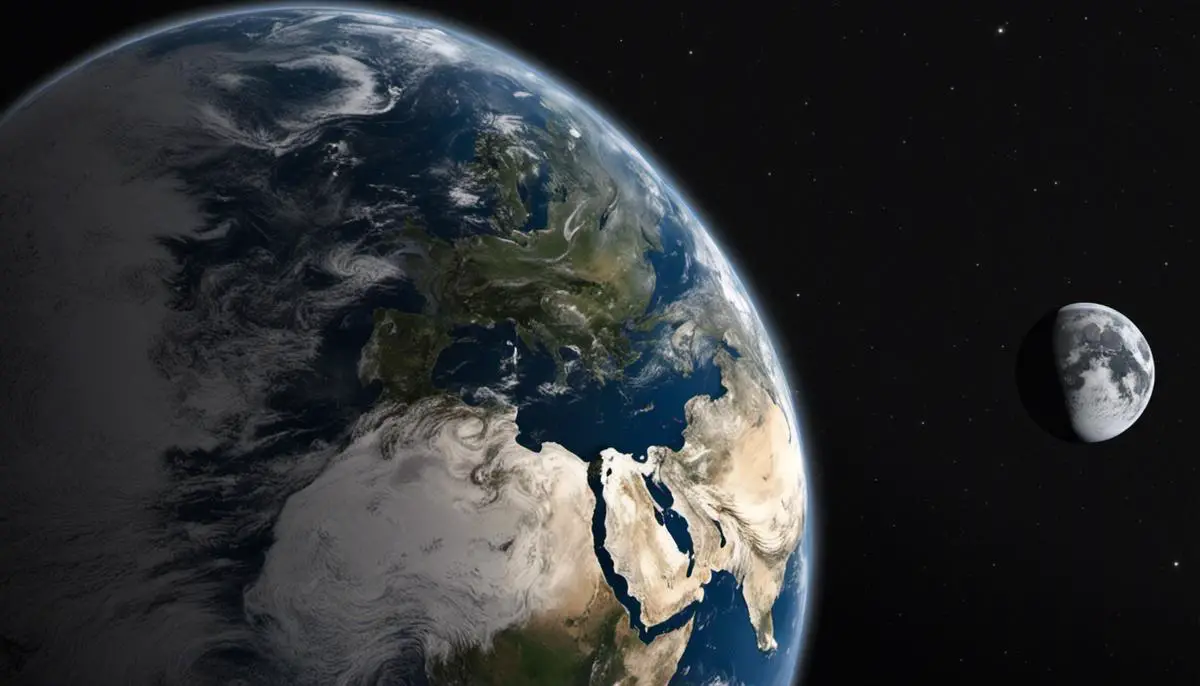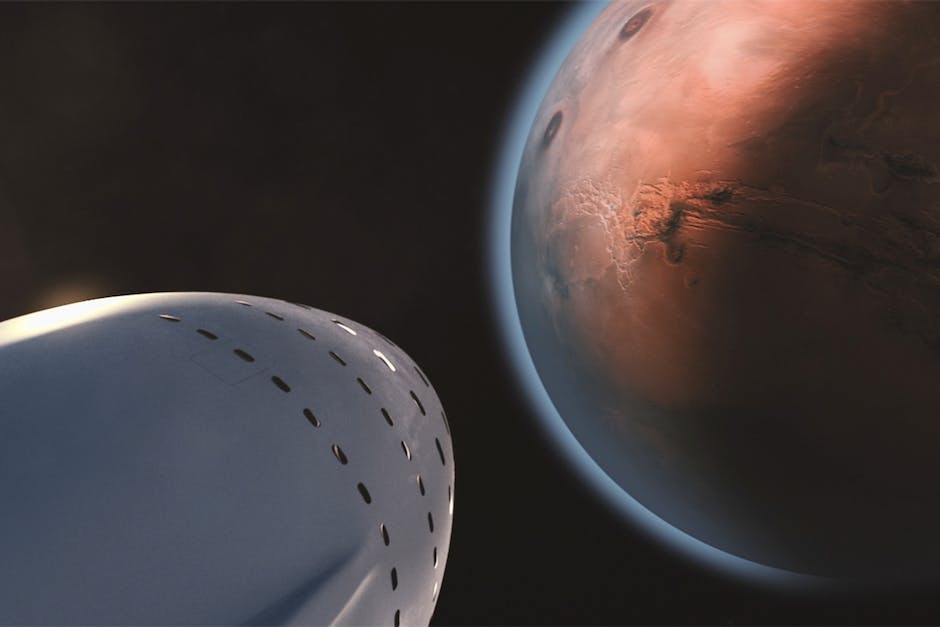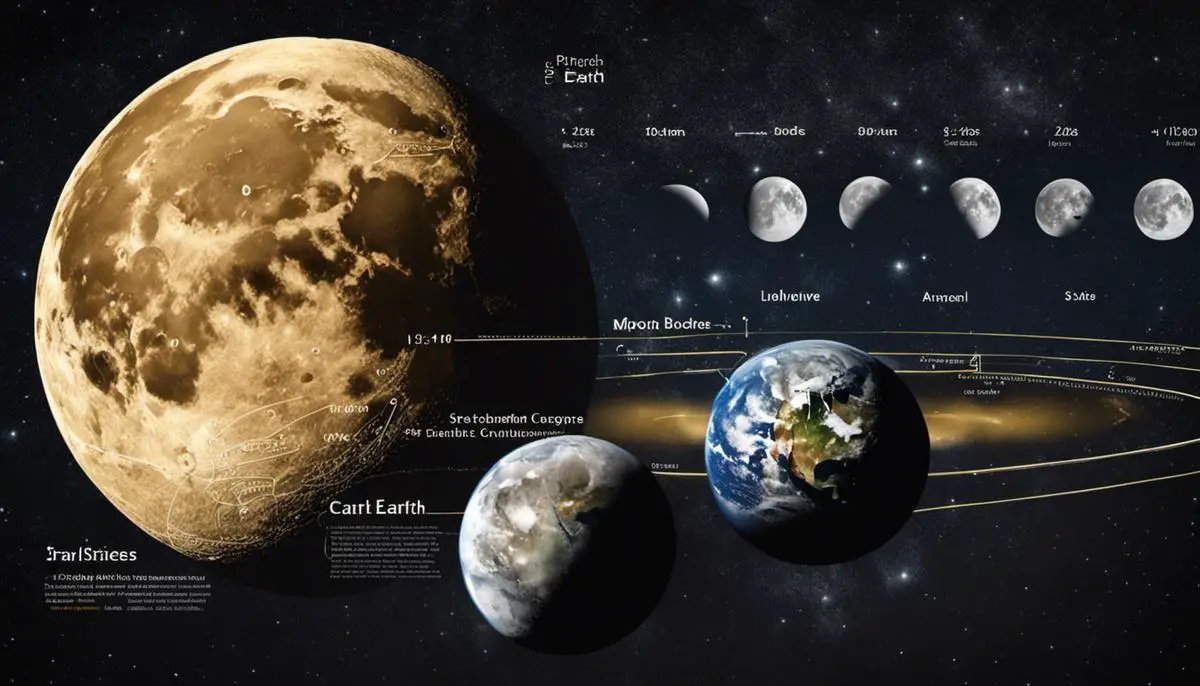The Moon, the Earth’s only natural satellite, has been a topic of wonderment and intrigue for humans throughout history. Its luminous presence in the night sky has been the subject of countless myths, religious beliefs, and scientific queries. While we perceive it as a prominent celestial body, the actual size of the Moon in relation to Earth is often misunderstood. The aim of this comprehensive exploration is to unveil the physical dimensions of the Moon as compared to Earth, the visual perception of its size from our perspective, the effects of its size on our planet, and the myths and misconceptions pertaining to its size that have circulated through history.
Physical Sizes of the Moon and Earth
Physical Sizes of the Moon and Earth
The Earth has a mean diameter of approximately 7,918 miles (12,742 kilometers). The equatorial diameter is slightly larger at around 7,926 miles (12,756 kilometers) due to the oblate spheroid shape of the Earth, meaning it is fatter at the equator and flatter at the poles. The polar diameter is slightly less, at around 7,900 miles (12,720 kilometers).
In contrast, the Moon’s diameter is much smaller. The mean diameter of the moon is about 2,159 miles (3,475 kilometers). This is nearly 27.3% of the Earth’s diameter, making it significantly smaller in size when compared to our planet.
The Earth’s circumference is about 24,901 miles (40,075 kilometers) at the equator. Meanwhile, the Moon’s circumference, at its equator, is approximately 6,783 miles (10,917 kilometers) – about 27.2% of the Earth’s equatorial circumference. Consequently, the Earth has about 3.67 times the girth of the moon.
The Evolution of Calculating Celestial Sizes
Our understanding of celestial sizes has continuously developed throughout human history. The pioneering work of Ancient Greeks, such as mathematician and geographer Eratosthenes, laid the groundwork by first estimating the Earth’s circumference. He accomplished this by calculating discrepancies in shadow lengths across different Earthly locations – a method still used in today’s Geometry and Geography teachings.
The Moon was a subject of similar curiosity. By the 2nd century BCE, Hipparchus calculated an estimate of the Moon’s size and distance from Earth using parallax – the perceptible change in location of an object, in this case, the Moon, when seen from two differing viewpoints on Earth.
With modern science, we’ve improved our measuring methods and honed our understanding of the Moon and Earth’s dimensions with superior precision. Honorably mentioning NASA, their missions like the Lunar Reconnaissance Orbiter have furnished us with detailed measurements of the Moon’s size. Meanwhile, satellites and radar measurements have exponentially enhanced our comprehension of Earth’s dimensions.
Regardless of precise measurements, it is the unique binary relationship between Earth and its Moon that is critical. This relationship fundamentally shapes life and environmental rhythm on Earth. Moreover, understanding their sizes provides insight into how they interact within the broader solar system.

Moon’s Size Visualized in Relation to Earth
Comparing Sizes: Moon Vs. Earth
Unquestionably distinguished in our night sky, the Moon is the only natural satellite of Earth and ranks fifth in the size chart of the largest moons in our solar system. Its diameter is approximately 2,159 miles (or 3,475 kilometers), making it about a quarter the size of Earth, whose diameter measures approximately 7,917.5 miles (or 12,742 kilometers). In terms of volume, this renders a unique comparison – over 50 Moons could neatly fit inside a hollow Earth.
A Visual Journey: Comparing Earth and Moon
Appreciating the size difference between Earth and Moon can be difficult without visual aids. By placing the two side-by-side, we realize that the Moon’s relative ‘smallness’ is instrumental for solar and lunar eclipses to take place.
Moreover, various space missions have captured images that starkly contrast the sizes of Earth and the Moon. Notably, the iconic photo of Earthrise, captured by Apollo 8 in 1968, shows a multicolored Earth against the Moon’s gray barren landscape, emphasizing not only their size differences but also the stark differences in terrain and color.
Understanding the Size Perception: Lunar Illusion
The Moon tends to appear larger to us when it is near the horizon, a phenomenon known as the ‘Moon illusion.’ However, this variation in perceived size is just an optical illusion. The moon does not physically grow in size; its perceived changes are due to our mind’s interpretation of the Moon’s position relative to objects on the horizon.
The Size Effect: Influences on Tides and Eclipses
The Moon’s relative size and proximity to Earth have significant impacts on our planet. The Moon is primarily responsible for Earth’s tides due to its gravitational pull. When it comes to solar and lunar eclipses, the Moon’s perceived size from Earth becomes crucial. Remarkably, from our perspective, the Sun and Moon appear nearly the same size in the sky, allowing the Moon to perfectly eclipse the Sun during total solar eclipses.
The size of the Moon in relation to Earth is markedly smaller, drawing an enticing image of the balanced and dynamic world in which we reside. Grasping the magnitude of this difference offers us crucial understanding into the fascinating inner workings of our solar system, natural phenomena occurring on Earth, and especially the role played by the Moon’s size in these events.

Effect of Moon’s Size on Earth
How the Moon’s Size Influences Earth’s Tides
Tides on Earth are primarily dictated by the gravitational pull of the Moon, and to a smaller degree, that of the Sun. The Moon’s gravity induces bulges in Earth’s oceans, resulting in two high tides round the clock. One high tide can be observed on the side closest to the Moon, where its gravitational force is at its peak. The other high tide is observed on the far side of Earth, where the weaker gravitational force causes the water to lag behind Earth’s rotation. The magnitude of these tides is directly proportional to the Moon’s size. Were the Moon smaller, its gravitational pull on Earth would also lessen, subsequently leading to lower tides.
Impact on the Earth’s Rotation Axis
The size of the Moon also has a significant influence on Earth’s axial stability. The gravitational interaction between Earth and Moon acts as a stabilizer for Earth’s axial tilt, maintaining it at approximately 23.5 degrees relative to its orbit around the Sun. This axial tilt is what gives us our seasonal changes, and if the Moon were smaller, its gravitational influence would be weaker, causing large variations in Earth’s axial tilt and consequently, more drastic changes in climate and temperature.
Eclipses and the Size of the Moon
An eclipse occurs when the Earth, the Sun, and the Moon align. Solar eclipses, where the Moon passes between Earth and the Sun, can only occur because of a remarkable celestial coincidence: the Sun is approximately 400 times wider than the Moon, but it is also about 400 times further away from Earth. Therefore, they appear roughly the same size in our sky. This allows the Moon to effectively cover the Sun during a total solar eclipse, a phenomenon utterly dependent on the Moon’s size in relation to Earth. A smaller moon would not sufficiently block the Sun, preventing total solar eclipses from occurring.
Moon’s Impact on Earth’s Rotation
The Moon and Earth have an intricate gravitational relationship that has a profound impact on our planet’s rotation. The Moon’s gravitational pull tugs on Earth’s water, creating a “drag” or “braking” force that slows down the Earth’s spin gradually over time. This phenomenon, known as tidal friction, is incrementally lengthening our days. In essence, the size of the moon has a correlation with Earth’s temporal period, where a smaller moon would logically contribute to abbreviated days.
Misconceptions and Myths about the Moon’s Size
Demystifying Misconceptions of the Moon’s Size
There are prevalent misconceptions concerning the Moon’s size, one of which is the well-known ‘Moon illusion’. This illusion occurs when the Moon is near the horizon, making it seem larger than when it is high in the sky. However, the Moon’s distance and size relatively remain constant and this apparent size change is a result of the way our brains interpret visual stimuli rather than any actual alteration in the Moon’s dimensions.
Additionally, there is a tendency to misconstrue the Moon’s apparent size (how large it seems from our perspective on Earth) with its actual size. The Moon can appear quite impressive during a full moon, but it is crucial to remember that, in reality, the Moon’s diameter is merely a fourth of Earth’s.
The Moon’s Size in Relation to Earth
Scientifically speaking, the Moon is about 2,160 miles in diameter, while Earth measures approximately 7,918 miles in diameter. Therefore, the Moon is roughly 27% the size of Earth, far smaller than many people imagine.
Historical and Cultural Views of the Moon’s Size
Historically, various cultures have had unique perceptions of the Moon’s size. Some ancient cultures believed the moon to be a mirror of Earth, with the same size and features. Meanwhile, early astronomers, such as Ptolemy in the 2nd century AD, made complicated calculations to estimate the Moon’s diameter correctly.
In folklore and popular culture, the Moon is sometimes depicted as larger than it is. Folktales and poems often portray the moon as a massive object in the sky, potentially contributing to misconceptions about its size.
Scientific Understanding vs. Public Perception
The gap between scientific understanding and public perception of the Moon’s size can be quite significant. Despite the scientific knowledge available, many still cling to misconceptions or are unaware of the Moon’s true proportions. Clearing these misconceptions requires us to blend scientific fact with a greater understanding of how perception and cultural context can influence our views of the natural world.

Having perused through the dimensions of the Earth and the Moon, visually compared their sizes, examined the Moon’s effects on Earth, and debunked various myths, it is evident that our celestial neighbor plays a larger role in our lives than just adorning the night sky. Though seemingly petite in the sky, the Moon has an immense physical size that directly influences various Earth phenomena. As we continue to learn more about this celestial body and our own planet, our comprehension continually expands, allowing us to understand and appreciate the intricate relationship between the Earth and the Moon.
FAQ
How big is the Moon compared to the Earth?
In terms of mass and diameter, the Moon is far smaller than the Earth. The Moon is roughly 3,474 kilometers (2,159 miles) in diameter, while the Earth is around 12,742 kilometers (7,918 miles) in diameter. The Moon’s mass is approximately 1/80th that of Earth. The Moon, though smaller in size, is an important component of Earth’s celestial dynamics, affecting tides and maintaining the planet’s axial tilt. When looking up into the night sky, one can clearly see how big the Earth is in comparison to the Moon, which appears to be a comparatively little satellite orbiting our much larger home planet.
How many Earths can fit in the Moon?
The Moon has a much lower volume and is substantially smaller than Earth. The idea that the Earth could accommodate about 49 moons can help one understand this discrepancy. The volume of the Earth is approximately 1 trillion cubic kilometers, but the Moon has a volume of roughly 2.2 billion cubic kilometers. When comparing the diameters and masses of the two heavenly bodies, it is clear that they are significantly different in size. Even while the Moon is very important to Earth because of its gravitational pull and its part in tidal cycles, it is still a very small neighbor in our cosmic neighborhood.
How many planets fit between Earth and moon?
On average, there are 384,400 kilometers (238,855 miles) separating Earth and the Moon. We would need to take into account the average diameter of a planet in order to calculate the number of planets that could fit in this space. The diameter of the Earth is approximately 12,742 kilometers (7,918 miles) for context. This number indicates that about thirty Earth-sized planets may fit in the space between Earth and the Moon. It’s crucial to remember that this is a simplified calculation, and the precise figure would rely on the diameters of each planet taken into account. The enormous distance that separates Earth and the Moon serves as a constant reminder of the vastness of our solar system.
Is the Moon 1 16 the size of Earth?
Yes, the diameter and mass of the Moon are around one sixth and one eighth of Earth, respectively. The Moon is roughly 3,474 kilometers (2,159 miles) in diameter, while the Earth is around 12,742 kilometers (7,918 miles) in diameter. The Moon is the fifth largest moon in the solar system based on its size ratio to its home planet, making it Earth’s closest celestial neighbor. The Moon, despite its lesser size, is an important component of Earth’s celestial mechanics, affecting tides and helping to maintain the stability of the axial tilt of our planet. When viewing the Moon in the night sky, the difference in size becomes apparent; it appears as a modest yet fascinating presence next to its much larger planetary companion.
Does Earth have 1 or 2 moons?
There is only one natural moon on Earth, which people just call “the Moon.” For billions of years, Earth has been accompanied continuously by this single natural satellite, which is crucial to many facets of the dynamics of our planet, including the gravitational forces that control the tides. Although there have been cases of transitory captured objects, such as asteroids, briefly joining Earth’s orbit before returning to their original course through space, these are not regarded as permanent moons. Therefore, it is correct to state that Earth has a single primary moon when speaking of the planet’s natural satellites.
Is the Moon 25% the size of Earth?
No, Earth’s size is not 25% that of the Moon. The Moon is roughly 27.3% the size of Earth in terms of diameter. The diameter of the Moon is approximately 3,474 kilometers (2,159 miles), whereas the diameter of the Earth is approximately 12,742 kilometers (7,918 miles). The Moon is even smaller than Earth when considering its volumes or masses, making up only 1.2% of Earth’s mass. Despite its lesser size, the Moon is nevertheless very important because it interacts with Earth’s gravitational field, which influences tides and maintains the planet’s overall stability.
![]()
